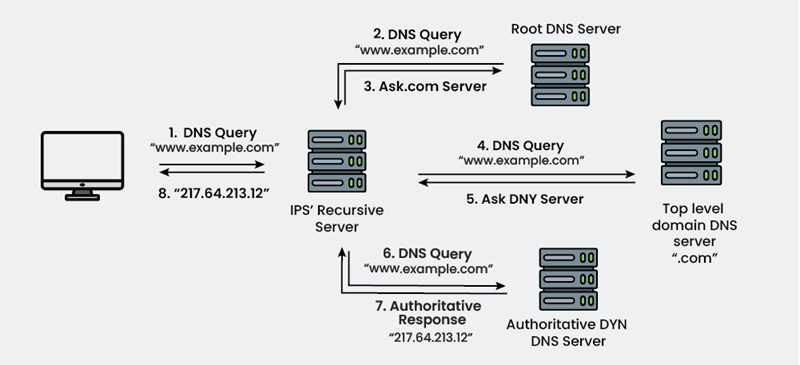The Domain Name System (DNS) is a critical component of the internet that helps translate human-readable domain names into numerical IP addresses that computers can understand. To fully comprehend how the DNS works, it is essential to understand some key terminology associated with it.
One such term is «domain name,» which refers to the unique name that identifies a website on the internet. These domain names are organized into a hierarchical structure, with the top-level domain (TLD) being the highest level, followed by second-level domains and subdomains. Another important term is «domain registrar,» which is a company that manages the reservation of domain names for individuals and organizations.
DNS servers are also crucial in the functioning of the DNS, as they store and distribute the IP address information associated with domain names. Additionally, the term «DNS resolution» is used to describe the process of translating a domain name into an IP address through the DNS system. By understanding these key terms and their roles in the DNS, one can gain a better appreciation for how this system facilitates communication on the internet.

Key Concepts in DNS Terminology
DNS, or Domain Name System, is a crucial component of the internet that translates human-readable domain names into IP addresses that computers can understand. Understanding key concepts in DNS terminology is essential for anyone working with websites or network infrastructure. One important term is «Domain Name,» which is the unique name that identifies a website on the internet. Another key concept is «IP Address,» which is a numerical label assigned to each device connected to a computer network that uses the Internet Protocol for communication.
«DNS Server» refers to a computer server that contains a database of public IP addresses and their associated domain names. «DNS Resolution» is the process of converting a domain name into an IP address. «DNS Cache» stores recently accessed domain names and their corresponding IP addresses, reducing the time it takes to resolve future requests. «Top-Level Domain» refers to the last part of a domain name, such as .com, .org, or .net.
«Name Server» is a server that is responsible for translating domain names into IP addresses. Understanding these key concepts in DNS terminology is essential for troubleshooting network issues, configuring DNS settings, and ensuring the smooth operation of websites and online services. It is important to stay informed about DNS terminology to effectively manage and maintain internet infrastructure.
Internet Users’ Glossary
The Internet Users’ Glossary is a comprehensive resource that provides individuals with a better understanding of the various terms and phrases commonly used in the online world. This glossary serves as a valuable tool for those who may be new to the internet or unfamiliar with the terminology associated with it.
By providing definitions and explanations for terms such as «URL,» «cookie,» and «phishing,» the glossary helps users navigate the digital landscape more effectively. In addition to defining technical jargon, the glossary also includes terms related to online behavior and etiquette, such as «trolling» and «flaming.»
By familiarizing themselves with these terms, internet users can communicate more effectively with others and avoid misunderstandings. Overall, the Internet Users’ Glossary is a valuable resource that empowers individuals to make informed decisions and navigate the online world with confidence.

NAT Terminology and Considerations
Network Address Translation (NAT) is a crucial component of modern networking, allowing multiple devices to share a single public IP address. There are several key terms associated with NAT that are important to understand. First, there is the concept of an inside local address, which is the private IP address assigned to a device within a local network.
This address is hidden from the outside world by the NAT device. Next, there is the inside global address, which is the public IP address that the NAT device presents to the outside world on behalf of the inside local address. This allows devices within the local network to communicate with external devices over the internet.
Additionally, there is the concept of an outside local address, which is the private IP address of a device on an external network that is communicating with a device on the local network. Finally, there is the outside global address, which is the public IP address of a device on an external network that is communicating with a device on the local network.
When considering NAT in a networking environment, there are several factors to take into account. For example, it is important to consider the type of NAT being used, such as static NAT, dynamic NAT, or PAT (Port Address Translation). Each type of NAT has its own advantages and limitations, so it is important to choose the right type for the specific networking requirements.
Additionally, it is important to consider the impact of NAT on network performance. NAT can introduce latency and reduce network throughput, so it is important to carefully plan NAT deployment to minimize these effects. Finally, it is important to consider the security implications of NAT. While NAT can provide a certain level of security by hiding internal IP addresses from external networks, it is not a substitute for proper network security measures such as firewalls and intrusion detection systems.
By understanding NAT terminology and considering these important factors, network administrators can effectively deploy NAT in their networks to enable secure and efficient communication between devices.

Diffserv Terminology and Clarifications
Differentiated Services (Diffserv) is a framework used in computer networking to classify and manage network traffic in order to provide quality of service (QoS) for different types of traffic. In order to better understand Diffserv, it is important to clarify some key terminology. One important term to understand is the Differentiated Services Code Point (DSCP), which is a value contained in the IP header of a packet that indicates the desired level of service for that packet.
Another important term is Per-Hop Behavior (PHB), which describes the way in which a router should handle packets with a particular DSCP value. Additionally, the Diffserv Architecture includes concepts such as Traffic Conditioner, Traffic Conditioner Action, and Traffic Conditioner Selector, which work together to classify and manage traffic based on its characteristics.
It is also important to understand the concept of Service Level Agreement (SLA), which defines the level of service that a network provider guarantees to a customer. By clarifying these key terms and concepts, network administrators can better understand how to implement and manage a Diffserv network in order to optimize performance and ensure quality of service for different types of traffic.
Terminology for Internet Connectivity
In the realm of internet connectivity, there is a vast array of terminology used to describe various aspects of how devices are connected to the internet. From broadband to Wi-Fi to cellular data, each term represents a different method of accessing the online world.
Broadband refers to high-speed internet access that is always on and allows for faster data transmission. Wi-Fi, short for wireless fidelity, is a technology that allows devices to connect to the internet wirelessly within a certain range of a router. Cellular data is the use of a mobile network to access the internet on devices such as smartphones and tablets. Other terms used to describe internet connectivity include Ethernet, which is a type of wired connection commonly used for desktop computers, and hotspots, which are public places where Wi-Fi is available for use.
Understanding these terms is essential for navigating the world of internet connectivity and ensuring that devices are able to access the online resources needed for work, communication, and entertainment. Whether at home, in the office, or on the go, having a solid understanding of the terminology for internet connectivity can help individuals make informed decisions about how to stay connected in an increasingly digital world.
